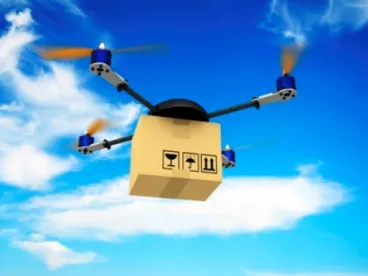The Federal Aviation Administration (FAA) on June 21, 2016 announced its long-awaited rule to allow commercial drone operators to legally fly their drones for pay and/or hire in the United States.1 The new rule2 will take effect in August 2016 and is the first of several that will likely spur a massive expansion of the commercial use of drones in the coming years.3
The new rule provides a common-sense framework based on the risk of injury or damage to people and property, and will likely be applauded by businesses across the country for its flexibility. For example, the new rule allows daylight and twilight flights of a drone weighing 55 lbs. or less, within visual line-of-sight of the operator under atmospheric conditions that provide for at least 3 miles of visibility and for flights up to 400 feet above ground level, so long as the drone is not flown over any persons not directly participating in the operation, under a covered structure or inside a stationary vehicle. To appease operators in non-urban areas, the rule allows a drone to be operated from a moving vehicle so long as the operation is in a sparsely populated area. In addition, the rule provides for a relatively high maximum ground speed not to exceed 100 mph, which will allow the use of a relatively large, fixed wing drone over large swaths of land. Importantly, many of the requirements of the rule are waivable, which means an operator who wants to fly outside of any of the stated parameters of the rule may obtain specific authorization from the FAA to do so. The rule does not require that the drone include or carry any particular equipment for avoidance of other aircraft or structures.
The rule also establishes new, relatively inexpensive certification requirements for drone pilots and places responsibility for conforming to the new rules squarely on the pilot. For example, the rule establishes a new “remote pilot in command” position and a “remote pilot airman certificate with a small UAS type rating,” which can be obtained by persons 16 years and older who have been vetted by the Transportation Security Administration (TSA) by passing an aeronautical knowledge test at an FAA-approved knowledge testing center, or if already a holder of a pilot certificate under Part 61 (other than a student certificate), by completing a flight review within the prior 24 months and by completing a small UAS online training course provided by the FAA. During operation of a drone for commercial purposes, the remote pilot in command must adhere to all aspects of the new rule while also complying with all FAA designated flight restrictions (i.e., such as those that prohibit flights over sporting event stadiums and the like), as well as all other existing rules applicable for manned aircraft. In other words, the onus will be on the pilot to observe all local, state and FAA rules applicable to any given flight.
So what does all of this mean? It means, for example, that hoteliers and owners of real estate may now seriously wish to consider commissioning drone flights over their property by a properly certified remote pilot to ensure the security of guests and of the property itself, or to track physical changes to the property over time. It means fire departments, police departments, search and rescue crews, insurance companies, and news gathering businesses may be able to quickly deploy low-cost drones to acquire and retransmit real-time audio and video over emergency scenes (e.g., vehicle crashes), natural disaster scenes (e.g., areas affected by flooding, earthquakes and tornados), or other newsworthy scenes without having to first obtain FAA approval. It means companies engaged in the mining, utility, farming and forestry industries may be capable of utilizing drones to conduct low-cost aerial surveys of large tracts of land for viewing or sensing geology, wildlife, vegetation and timber resources without first having to seek FAA approval. All of these probable activities will necessarily create data – and tons of it – together with the attendant concerns for data privacy and security. New markets for companies involved in data protection and insurance will likely occur, and new companies will form to engage in drone hardware development, software development and the like.
To be sure, the new rule will not help everyone. For example, a drone pilot may only fly one drone at a time even though technology already exists to simultaneously fly multiple drones in coordinated fashion with one another. A drone pilot cannot fly a drone over persons not involved in the operation, which will limit the circumstances and location of certain flights to ensure that innocent bystanders are not exposed to undue risk of injury. A drone pilot cannot fly outside his/her visual line-of-sight or beyond visual range even though technology exists to allow autonomous flight well beyond visual range. Consequently, package delivery companies will likely need to obtain a waiver to fly packages point-to-point outside the visual line-of-sight of the pilot.
In much the same way as the land rush of the 1800s, the new rule will usher in a new wave of aspiring businesses and purposes for flying drones. However, as with any change in the law, companies who want to operate a drone for pay or hire or who commission others to do so for their benefit should consult with their legal team to ensure compliance with the new rule.
__________________
1 See, https://www.faa.gov/news/press_releases/news_story.cfm?newsId=20515
2 The new rule will be codified in 14 C.F.R. §107. The full text of the rule is available here:
http://www.faa.gov/uas/media/RIN_2120-AJ60_Clean_Signed.pdf
An FAA summary of the rule is available here:
http://www.faa.gov/uas/media/Part_107_Summary.pdf
3 Depending on which forecast is used, the FAA estimates that the rule will result in a net social benefit ranging from about $733 million in the low case to about $9.0 billion in the high case over five years. See page 14 of the rule at:
http://www.faa.gov/uas/media/RIN_2120-AJ60_Clean_Signed.pdf





 />i
/>i

